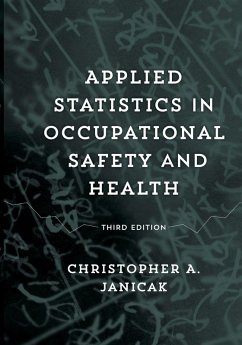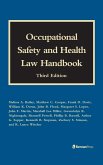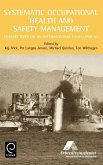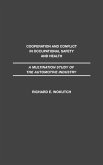Christopher A. Janicak
Applied Statistics in Occupational Safety and Health
Christopher A. Janicak
Applied Statistics in Occupational Safety and Health
- Broschiertes Buch
- Merkliste
- Auf die Merkliste
- Bewerten Bewerten
- Teilen
- Produkt teilen
- Produkterinnerung
- Produkterinnerung
Applied Statistics in Occupational Safety and Health provides occupational safety and health professionals with an introductory guide to basic statistics and data analysis. This book is written in an easy-to-understand format with step-by-step procedures to analyze data using ...
Andere Kunden interessierten sich auch für
![Applied Statistics in Occupational Safety and Health Applied Statistics in Occupational Safety and Health]() Christopher A. JanicakApplied Statistics in Occupational Safety and Health117,99 €
Christopher A. JanicakApplied Statistics in Occupational Safety and Health117,99 €![Fundamentals of Occupational Safety and Health Fundamentals of Occupational Safety and Health]() Mark A. FriendFundamentals of Occupational Safety and Health128,99 €
Mark A. FriendFundamentals of Occupational Safety and Health128,99 €![Occupational Safety and Health Law Handbook Occupational Safety and Health Law Handbook]() Melissa A. BaileyOccupational Safety and Health Law Handbook149,99 €
Melissa A. BaileyOccupational Safety and Health Law Handbook149,99 €![Systematic Occupational Health and Safety Management Systematic Occupational Health and Safety Management]() K. Frick / P.L. Jensen / M. Quinlan / T. Wilthagen (eds.)Systematic Occupational Health and Safety Management241,99 €
K. Frick / P.L. Jensen / M. Quinlan / T. Wilthagen (eds.)Systematic Occupational Health and Safety Management241,99 €![Cooperation and Conflict in Occupational Safety and Health Cooperation and Conflict in Occupational Safety and Health]() Richard E. WokutchCooperation and Conflict in Occupational Safety and Health102,99 €
Richard E. WokutchCooperation and Conflict in Occupational Safety and Health102,99 €![Computer Systems for Occupational Safety and Health Management Computer Systems for Occupational Safety and Health Management]() Charles W. RossComputer Systems for Occupational Safety and Health Management207,99 €
Charles W. RossComputer Systems for Occupational Safety and Health Management207,99 €![Establishing an occupational health & safety management system based on ISO 45001 Establishing an occupational health & safety management system based on ISO 45001]() Naeem SadiqEstablishing an occupational health & safety management system based on ISO 4500146,99 €
Naeem SadiqEstablishing an occupational health & safety management system based on ISO 4500146,99 €-
-
-
Applied Statistics in Occupational Safety and Health provides occupational safety and health professionals with an introductory guide to basic statistics and data analysis. This book is written in an easy-to-understand format with step-by-step procedures to analyze data using ...
Hinweis: Dieser Artikel kann nur an eine deutsche Lieferadresse ausgeliefert werden.
Hinweis: Dieser Artikel kann nur an eine deutsche Lieferadresse ausgeliefert werden.
Produktdetails
- Produktdetails
- Verlag: Bernan Press
- Third Edition
- Seitenzahl: 190
- Erscheinungstermin: 9. Januar 2017
- Englisch
- Abmessung: 254mm x 178mm x 10mm
- Gewicht: 369g
- ISBN-13: 9781598888881
- ISBN-10: 1598888889
- Artikelnr.: 47123659
- Herstellerkennzeichnung
- Libri GmbH
- Europaallee 1
- 36244 Bad Hersfeld
- gpsr@libri.de
- Verlag: Bernan Press
- Third Edition
- Seitenzahl: 190
- Erscheinungstermin: 9. Januar 2017
- Englisch
- Abmessung: 254mm x 178mm x 10mm
- Gewicht: 369g
- ISBN-13: 9781598888881
- ISBN-10: 1598888889
- Artikelnr.: 47123659
- Herstellerkennzeichnung
- Libri GmbH
- Europaallee 1
- 36244 Bad Hersfeld
- gpsr@libri.de
By Christopher A. Janicak
Contents List of Figures and Tables Preface About the Author 1 Fundamentals of Statistics Statistics and Their Use in Safety Statistics Defined Common Terms and Notations Quantitative and Qualitative Data Statistical Notations Research Questions and Hypotheses Types of Studies
Retrospective Studies
Prospective Studies
Experiments Statistical Samples versus Statistical Populations Bias Probability Sample Selection Procedures Sampling Techniques
Random Samples
Simple Random Samples
Cluster Samples
Stratified Random Samples Nonprobability Sample Selection Procedures
Chunk Sampling
Volunteer Samples Variables
Dependent and Independent Variables Chapter Summary Chapter Review Exercises 2 Probability and Chance Probability Marginal Probabilities
Joint Event Probabilities Union Probabilities
Conditional Probabilities Factorials, Permutations, Ordered Combinations, and Combinations Factorials
Permutations
Combinations Binomial Probabilities Poisson Probability Chapter Summary Chapter Review Exercises 3 Distributions Statistical Distributions and Populations Frequencies Histograms Frequency Polygons Percentages, Cumulative Percentages, and Percentiles Normal Distribution Binomial Distribution t Distribution Chi-square Distribution F Distribution Chapter Summary Chapter Review Exercises 4 Descriptive Statistics Data Formats
Categorical Data
Ordinal Data
Interval Data
Ratio Data Strength of the Data Formats Measures of Central Tendency
Mean
Median
Mode Measures of Variability
Range
Variance
Standard Deviation
Interquartile Range z Scores
z Scores and Percentages of the Population Confidence Intervals for Means
95% Confidence Intervals
99% Confidence Intervals
Interpreting Confidence Intervals Chapter Summary Chapter Review Exercises 5 Statistical Tests Statistical Hypotheses Inferential Statistical Testing Type I and Type II Errors Alpha Levels Statistical Power of a Test Inferential Statistics Test Procedure
Developing a Statistical Hypothesis
Choosing the Appropriate Statistical Test or Procedure
Determining the Statistical Distribution
Determining Significance Levels
Formulating a Decision Rule
Running the Test
Formulating a Conclusion and Making a Decision Chapter Summary Chapter Review Exercises 6 Inferential Statistics for Means z-Test Comparing a Sample Mean to a Known Population Mean
Test Assumptions
Hypothesis Construction
Determine Significance Levels
Using a z Table
Formulate a Decision Rule
z Test Formula
Conclusions
Example z Test Problem Independent Samples z-Test
Test Assumptions
Independent Samples z-Test Formula
Example Independent Samples z-test Problem
Hypothesis Construction
Conclusions
Example z Test Problem t -Test for a Single Mean
Test Assumptions
Hypothesis Construction
t Test Hypotheses
Determine Significance Levels
Formulate a Decision Rule
t-Test Formula for a Single Mean
Conclusions
Example t-Test Problem t-Test for Independent Samples Paired Samples t-Tests
Test Assumptions
Hypothesis Construction
Determine Significance Levels
Formulate a Decision Rule
Test Formula
Conclusions
Example Paired Samples t-Test Problem One-way Analysis of Variance
Procedure Assumptions
Hypothesis Construction
Procedure Formulas
Hypothesis Construction
Formulate a Decision Rule
Calculate F Ratio
Conclusions Post Hoc Procedures Tukey's HSD
Calculate Tukey's HSD
Formulate a Decision Rule
Example ANOVA Problem
Formulate a Decision Rule
Calculate F ratio
Conclusions
Run Post Hoc Tests Chapter Summary Chapter Review Exercises 7 Correlation and Regression Correlation
Pearson Correlation Coefficient
Assumptions
Pearson Correlation Coefficient Formula
Sample Problem
Significance Testing for Correlation Coefficients
Test Hypotheses
Test Formula
Sample Problem
Spearman Rank-Order Correlation Coefficient
Assumptions
Spearman Rank-Order Correlation Coefficient Formula
Sample Problem
Phi Coefficient
Assumptions
Phi Coefficient Formula
Sample Problem
Point Biserial Correlation
Assumptions
Point Biserial Correlation Formula
Sample Problem
Significance Testing for Correlation Coefficients Linear Regression
Procedure Assumptions
Linear Regression Formulas
Sample Problem Chapter Summary Chapter Review Exercises 8 Nonparametric Statistics Underlying Assumptions Concerning Nonparametric Statistics Chi-square Test for Goodness of Fit
Degrees of Freedom
Test Assumptions
Hypothesis Construction
Test Formula
Determining the Critical Value
Sample Problem c2 Test of Independence
Degrees of Freedom
Expected Number of Cases
Test Assumptions
Hypothesis Construction
Test Formula
Sample Problem Cochran's Q Test
Test Assumptions
Hypothesis Construction
Cochran's Q Test Formula
Sample Problem Cochran's Q Test
Test Assumptions
Hypothesis Construction
Test Formula
Sample Problem Chapter Summary Chapter Review Exercises 9 Survey Research Types of Survey Studies Collecting and Maintaining Survey Data Outline for Planning a Survey Constructing the Instrument Types of Survey Items Forms of Questions
Unstructured Questions
Structured Questions Rating Scales Likert Scales Semantic Differential Scales Formatting Questionnaires for the Mail Sound Survey Research Procedures
Measurable Objective
Representative Population
Match the Hypothesis to the Statistical Tests
Conduct Background Research
Instrument Validity and Reliability
Cover Letters and Instructions
Sampling for Surveys
Calculating Sample Sizes
Survey Research Limitations
Pilot Testing
Permission to Use Human Subjects Chapter Summary Chapter Review Exercises 10 Experimental Design Experimental Design Uses Research Hypotheses and Experimental Design Dependent and Independent Variables Types of Experimental Designs
One-way ANOVA
Completely Randomized Design
Randomized Block Design
Latin Square Design
Completely Randomized Factorial Design Chapter Summary Chapter Review Exercises 11 Presenting Research Data Presentation for Safety Professionals Displaying Descriptive Statistics
Displaying Tables
Column Charts
Pie Charts Presenting Inferential Statistics
z-Tests and t-Tests
Example Results from a Paired t-Test Procedure
One-way Analysis of Variance
Correlation Procedures
Regression Procedures
Nonparametric Procedures Using Computer Software to Develop Presentations
Sample Data Analysis Using Microsoft Excel
Developing Presentations Using Microsoft Office Chapter Summary Chapter Review Exercises Appendix Statistical Tables
Cumulative Distribution Function for the Standard Normal Random Variable
Critical Values for the t Distribution
Critical Values for the Chi-square Distribution
Critical Values for the F Distribution
Table of Random Units
Critical Values of the Studentized Range Glossary References Solutions to Selected Problems Index
Retrospective Studies
Prospective Studies
Experiments Statistical Samples versus Statistical Populations Bias Probability Sample Selection Procedures Sampling Techniques
Random Samples
Simple Random Samples
Cluster Samples
Stratified Random Samples Nonprobability Sample Selection Procedures
Chunk Sampling
Volunteer Samples Variables
Dependent and Independent Variables Chapter Summary Chapter Review Exercises 2 Probability and Chance Probability Marginal Probabilities
Joint Event Probabilities Union Probabilities
Conditional Probabilities Factorials, Permutations, Ordered Combinations, and Combinations Factorials
Permutations
Combinations Binomial Probabilities Poisson Probability Chapter Summary Chapter Review Exercises 3 Distributions Statistical Distributions and Populations Frequencies Histograms Frequency Polygons Percentages, Cumulative Percentages, and Percentiles Normal Distribution Binomial Distribution t Distribution Chi-square Distribution F Distribution Chapter Summary Chapter Review Exercises 4 Descriptive Statistics Data Formats
Categorical Data
Ordinal Data
Interval Data
Ratio Data Strength of the Data Formats Measures of Central Tendency
Mean
Median
Mode Measures of Variability
Range
Variance
Standard Deviation
Interquartile Range z Scores
z Scores and Percentages of the Population Confidence Intervals for Means
95% Confidence Intervals
99% Confidence Intervals
Interpreting Confidence Intervals Chapter Summary Chapter Review Exercises 5 Statistical Tests Statistical Hypotheses Inferential Statistical Testing Type I and Type II Errors Alpha Levels Statistical Power of a Test Inferential Statistics Test Procedure
Developing a Statistical Hypothesis
Choosing the Appropriate Statistical Test or Procedure
Determining the Statistical Distribution
Determining Significance Levels
Formulating a Decision Rule
Running the Test
Formulating a Conclusion and Making a Decision Chapter Summary Chapter Review Exercises 6 Inferential Statistics for Means z-Test Comparing a Sample Mean to a Known Population Mean
Test Assumptions
Hypothesis Construction
Determine Significance Levels
Using a z Table
Formulate a Decision Rule
z Test Formula
Conclusions
Example z Test Problem Independent Samples z-Test
Test Assumptions
Independent Samples z-Test Formula
Example Independent Samples z-test Problem
Hypothesis Construction
Conclusions
Example z Test Problem t -Test for a Single Mean
Test Assumptions
Hypothesis Construction
t Test Hypotheses
Determine Significance Levels
Formulate a Decision Rule
t-Test Formula for a Single Mean
Conclusions
Example t-Test Problem t-Test for Independent Samples Paired Samples t-Tests
Test Assumptions
Hypothesis Construction
Determine Significance Levels
Formulate a Decision Rule
Test Formula
Conclusions
Example Paired Samples t-Test Problem One-way Analysis of Variance
Procedure Assumptions
Hypothesis Construction
Procedure Formulas
Hypothesis Construction
Formulate a Decision Rule
Calculate F Ratio
Conclusions Post Hoc Procedures Tukey's HSD
Calculate Tukey's HSD
Formulate a Decision Rule
Example ANOVA Problem
Formulate a Decision Rule
Calculate F ratio
Conclusions
Run Post Hoc Tests Chapter Summary Chapter Review Exercises 7 Correlation and Regression Correlation
Pearson Correlation Coefficient
Assumptions
Pearson Correlation Coefficient Formula
Sample Problem
Significance Testing for Correlation Coefficients
Test Hypotheses
Test Formula
Sample Problem
Spearman Rank-Order Correlation Coefficient
Assumptions
Spearman Rank-Order Correlation Coefficient Formula
Sample Problem
Phi Coefficient
Assumptions
Phi Coefficient Formula
Sample Problem
Point Biserial Correlation
Assumptions
Point Biserial Correlation Formula
Sample Problem
Significance Testing for Correlation Coefficients Linear Regression
Procedure Assumptions
Linear Regression Formulas
Sample Problem Chapter Summary Chapter Review Exercises 8 Nonparametric Statistics Underlying Assumptions Concerning Nonparametric Statistics Chi-square Test for Goodness of Fit
Degrees of Freedom
Test Assumptions
Hypothesis Construction
Test Formula
Determining the Critical Value
Sample Problem c2 Test of Independence
Degrees of Freedom
Expected Number of Cases
Test Assumptions
Hypothesis Construction
Test Formula
Sample Problem Cochran's Q Test
Test Assumptions
Hypothesis Construction
Cochran's Q Test Formula
Sample Problem Cochran's Q Test
Test Assumptions
Hypothesis Construction
Test Formula
Sample Problem Chapter Summary Chapter Review Exercises 9 Survey Research Types of Survey Studies Collecting and Maintaining Survey Data Outline for Planning a Survey Constructing the Instrument Types of Survey Items Forms of Questions
Unstructured Questions
Structured Questions Rating Scales Likert Scales Semantic Differential Scales Formatting Questionnaires for the Mail Sound Survey Research Procedures
Measurable Objective
Representative Population
Match the Hypothesis to the Statistical Tests
Conduct Background Research
Instrument Validity and Reliability
Cover Letters and Instructions
Sampling for Surveys
Calculating Sample Sizes
Survey Research Limitations
Pilot Testing
Permission to Use Human Subjects Chapter Summary Chapter Review Exercises 10 Experimental Design Experimental Design Uses Research Hypotheses and Experimental Design Dependent and Independent Variables Types of Experimental Designs
One-way ANOVA
Completely Randomized Design
Randomized Block Design
Latin Square Design
Completely Randomized Factorial Design Chapter Summary Chapter Review Exercises 11 Presenting Research Data Presentation for Safety Professionals Displaying Descriptive Statistics
Displaying Tables
Column Charts
Pie Charts Presenting Inferential Statistics
z-Tests and t-Tests
Example Results from a Paired t-Test Procedure
One-way Analysis of Variance
Correlation Procedures
Regression Procedures
Nonparametric Procedures Using Computer Software to Develop Presentations
Sample Data Analysis Using Microsoft Excel
Developing Presentations Using Microsoft Office Chapter Summary Chapter Review Exercises Appendix Statistical Tables
Cumulative Distribution Function for the Standard Normal Random Variable
Critical Values for the t Distribution
Critical Values for the Chi-square Distribution
Critical Values for the F Distribution
Table of Random Units
Critical Values of the Studentized Range Glossary References Solutions to Selected Problems Index
Contents List of Figures and Tables Preface About the Author 1 Fundamentals of Statistics Statistics and Their Use in Safety Statistics Defined Common Terms and Notations Quantitative and Qualitative Data Statistical Notations Research Questions and Hypotheses Types of Studies
Retrospective Studies
Prospective Studies
Experiments Statistical Samples versus Statistical Populations Bias Probability Sample Selection Procedures Sampling Techniques
Random Samples
Simple Random Samples
Cluster Samples
Stratified Random Samples Nonprobability Sample Selection Procedures
Chunk Sampling
Volunteer Samples Variables
Dependent and Independent Variables Chapter Summary Chapter Review Exercises 2 Probability and Chance Probability Marginal Probabilities
Joint Event Probabilities Union Probabilities
Conditional Probabilities Factorials, Permutations, Ordered Combinations, and Combinations Factorials
Permutations
Combinations Binomial Probabilities Poisson Probability Chapter Summary Chapter Review Exercises 3 Distributions Statistical Distributions and Populations Frequencies Histograms Frequency Polygons Percentages, Cumulative Percentages, and Percentiles Normal Distribution Binomial Distribution t Distribution Chi-square Distribution F Distribution Chapter Summary Chapter Review Exercises 4 Descriptive Statistics Data Formats
Categorical Data
Ordinal Data
Interval Data
Ratio Data Strength of the Data Formats Measures of Central Tendency
Mean
Median
Mode Measures of Variability
Range
Variance
Standard Deviation
Interquartile Range z Scores
z Scores and Percentages of the Population Confidence Intervals for Means
95% Confidence Intervals
99% Confidence Intervals
Interpreting Confidence Intervals Chapter Summary Chapter Review Exercises 5 Statistical Tests Statistical Hypotheses Inferential Statistical Testing Type I and Type II Errors Alpha Levels Statistical Power of a Test Inferential Statistics Test Procedure
Developing a Statistical Hypothesis
Choosing the Appropriate Statistical Test or Procedure
Determining the Statistical Distribution
Determining Significance Levels
Formulating a Decision Rule
Running the Test
Formulating a Conclusion and Making a Decision Chapter Summary Chapter Review Exercises 6 Inferential Statistics for Means z-Test Comparing a Sample Mean to a Known Population Mean
Test Assumptions
Hypothesis Construction
Determine Significance Levels
Using a z Table
Formulate a Decision Rule
z Test Formula
Conclusions
Example z Test Problem Independent Samples z-Test
Test Assumptions
Independent Samples z-Test Formula
Example Independent Samples z-test Problem
Hypothesis Construction
Conclusions
Example z Test Problem t -Test for a Single Mean
Test Assumptions
Hypothesis Construction
t Test Hypotheses
Determine Significance Levels
Formulate a Decision Rule
t-Test Formula for a Single Mean
Conclusions
Example t-Test Problem t-Test for Independent Samples Paired Samples t-Tests
Test Assumptions
Hypothesis Construction
Determine Significance Levels
Formulate a Decision Rule
Test Formula
Conclusions
Example Paired Samples t-Test Problem One-way Analysis of Variance
Procedure Assumptions
Hypothesis Construction
Procedure Formulas
Hypothesis Construction
Formulate a Decision Rule
Calculate F Ratio
Conclusions Post Hoc Procedures Tukey's HSD
Calculate Tukey's HSD
Formulate a Decision Rule
Example ANOVA Problem
Formulate a Decision Rule
Calculate F ratio
Conclusions
Run Post Hoc Tests Chapter Summary Chapter Review Exercises 7 Correlation and Regression Correlation
Pearson Correlation Coefficient
Assumptions
Pearson Correlation Coefficient Formula
Sample Problem
Significance Testing for Correlation Coefficients
Test Hypotheses
Test Formula
Sample Problem
Spearman Rank-Order Correlation Coefficient
Assumptions
Spearman Rank-Order Correlation Coefficient Formula
Sample Problem
Phi Coefficient
Assumptions
Phi Coefficient Formula
Sample Problem
Point Biserial Correlation
Assumptions
Point Biserial Correlation Formula
Sample Problem
Significance Testing for Correlation Coefficients Linear Regression
Procedure Assumptions
Linear Regression Formulas
Sample Problem Chapter Summary Chapter Review Exercises 8 Nonparametric Statistics Underlying Assumptions Concerning Nonparametric Statistics Chi-square Test for Goodness of Fit
Degrees of Freedom
Test Assumptions
Hypothesis Construction
Test Formula
Determining the Critical Value
Sample Problem c2 Test of Independence
Degrees of Freedom
Expected Number of Cases
Test Assumptions
Hypothesis Construction
Test Formula
Sample Problem Cochran's Q Test
Test Assumptions
Hypothesis Construction
Cochran's Q Test Formula
Sample Problem Cochran's Q Test
Test Assumptions
Hypothesis Construction
Test Formula
Sample Problem Chapter Summary Chapter Review Exercises 9 Survey Research Types of Survey Studies Collecting and Maintaining Survey Data Outline for Planning a Survey Constructing the Instrument Types of Survey Items Forms of Questions
Unstructured Questions
Structured Questions Rating Scales Likert Scales Semantic Differential Scales Formatting Questionnaires for the Mail Sound Survey Research Procedures
Measurable Objective
Representative Population
Match the Hypothesis to the Statistical Tests
Conduct Background Research
Instrument Validity and Reliability
Cover Letters and Instructions
Sampling for Surveys
Calculating Sample Sizes
Survey Research Limitations
Pilot Testing
Permission to Use Human Subjects Chapter Summary Chapter Review Exercises 10 Experimental Design Experimental Design Uses Research Hypotheses and Experimental Design Dependent and Independent Variables Types of Experimental Designs
One-way ANOVA
Completely Randomized Design
Randomized Block Design
Latin Square Design
Completely Randomized Factorial Design Chapter Summary Chapter Review Exercises 11 Presenting Research Data Presentation for Safety Professionals Displaying Descriptive Statistics
Displaying Tables
Column Charts
Pie Charts Presenting Inferential Statistics
z-Tests and t-Tests
Example Results from a Paired t-Test Procedure
One-way Analysis of Variance
Correlation Procedures
Regression Procedures
Nonparametric Procedures Using Computer Software to Develop Presentations
Sample Data Analysis Using Microsoft Excel
Developing Presentations Using Microsoft Office Chapter Summary Chapter Review Exercises Appendix Statistical Tables
Cumulative Distribution Function for the Standard Normal Random Variable
Critical Values for the t Distribution
Critical Values for the Chi-square Distribution
Critical Values for the F Distribution
Table of Random Units
Critical Values of the Studentized Range Glossary References Solutions to Selected Problems Index
Retrospective Studies
Prospective Studies
Experiments Statistical Samples versus Statistical Populations Bias Probability Sample Selection Procedures Sampling Techniques
Random Samples
Simple Random Samples
Cluster Samples
Stratified Random Samples Nonprobability Sample Selection Procedures
Chunk Sampling
Volunteer Samples Variables
Dependent and Independent Variables Chapter Summary Chapter Review Exercises 2 Probability and Chance Probability Marginal Probabilities
Joint Event Probabilities Union Probabilities
Conditional Probabilities Factorials, Permutations, Ordered Combinations, and Combinations Factorials
Permutations
Combinations Binomial Probabilities Poisson Probability Chapter Summary Chapter Review Exercises 3 Distributions Statistical Distributions and Populations Frequencies Histograms Frequency Polygons Percentages, Cumulative Percentages, and Percentiles Normal Distribution Binomial Distribution t Distribution Chi-square Distribution F Distribution Chapter Summary Chapter Review Exercises 4 Descriptive Statistics Data Formats
Categorical Data
Ordinal Data
Interval Data
Ratio Data Strength of the Data Formats Measures of Central Tendency
Mean
Median
Mode Measures of Variability
Range
Variance
Standard Deviation
Interquartile Range z Scores
z Scores and Percentages of the Population Confidence Intervals for Means
95% Confidence Intervals
99% Confidence Intervals
Interpreting Confidence Intervals Chapter Summary Chapter Review Exercises 5 Statistical Tests Statistical Hypotheses Inferential Statistical Testing Type I and Type II Errors Alpha Levels Statistical Power of a Test Inferential Statistics Test Procedure
Developing a Statistical Hypothesis
Choosing the Appropriate Statistical Test or Procedure
Determining the Statistical Distribution
Determining Significance Levels
Formulating a Decision Rule
Running the Test
Formulating a Conclusion and Making a Decision Chapter Summary Chapter Review Exercises 6 Inferential Statistics for Means z-Test Comparing a Sample Mean to a Known Population Mean
Test Assumptions
Hypothesis Construction
Determine Significance Levels
Using a z Table
Formulate a Decision Rule
z Test Formula
Conclusions
Example z Test Problem Independent Samples z-Test
Test Assumptions
Independent Samples z-Test Formula
Example Independent Samples z-test Problem
Hypothesis Construction
Conclusions
Example z Test Problem t -Test for a Single Mean
Test Assumptions
Hypothesis Construction
t Test Hypotheses
Determine Significance Levels
Formulate a Decision Rule
t-Test Formula for a Single Mean
Conclusions
Example t-Test Problem t-Test for Independent Samples Paired Samples t-Tests
Test Assumptions
Hypothesis Construction
Determine Significance Levels
Formulate a Decision Rule
Test Formula
Conclusions
Example Paired Samples t-Test Problem One-way Analysis of Variance
Procedure Assumptions
Hypothesis Construction
Procedure Formulas
Hypothesis Construction
Formulate a Decision Rule
Calculate F Ratio
Conclusions Post Hoc Procedures Tukey's HSD
Calculate Tukey's HSD
Formulate a Decision Rule
Example ANOVA Problem
Formulate a Decision Rule
Calculate F ratio
Conclusions
Run Post Hoc Tests Chapter Summary Chapter Review Exercises 7 Correlation and Regression Correlation
Pearson Correlation Coefficient
Assumptions
Pearson Correlation Coefficient Formula
Sample Problem
Significance Testing for Correlation Coefficients
Test Hypotheses
Test Formula
Sample Problem
Spearman Rank-Order Correlation Coefficient
Assumptions
Spearman Rank-Order Correlation Coefficient Formula
Sample Problem
Phi Coefficient
Assumptions
Phi Coefficient Formula
Sample Problem
Point Biserial Correlation
Assumptions
Point Biserial Correlation Formula
Sample Problem
Significance Testing for Correlation Coefficients Linear Regression
Procedure Assumptions
Linear Regression Formulas
Sample Problem Chapter Summary Chapter Review Exercises 8 Nonparametric Statistics Underlying Assumptions Concerning Nonparametric Statistics Chi-square Test for Goodness of Fit
Degrees of Freedom
Test Assumptions
Hypothesis Construction
Test Formula
Determining the Critical Value
Sample Problem c2 Test of Independence
Degrees of Freedom
Expected Number of Cases
Test Assumptions
Hypothesis Construction
Test Formula
Sample Problem Cochran's Q Test
Test Assumptions
Hypothesis Construction
Cochran's Q Test Formula
Sample Problem Cochran's Q Test
Test Assumptions
Hypothesis Construction
Test Formula
Sample Problem Chapter Summary Chapter Review Exercises 9 Survey Research Types of Survey Studies Collecting and Maintaining Survey Data Outline for Planning a Survey Constructing the Instrument Types of Survey Items Forms of Questions
Unstructured Questions
Structured Questions Rating Scales Likert Scales Semantic Differential Scales Formatting Questionnaires for the Mail Sound Survey Research Procedures
Measurable Objective
Representative Population
Match the Hypothesis to the Statistical Tests
Conduct Background Research
Instrument Validity and Reliability
Cover Letters and Instructions
Sampling for Surveys
Calculating Sample Sizes
Survey Research Limitations
Pilot Testing
Permission to Use Human Subjects Chapter Summary Chapter Review Exercises 10 Experimental Design Experimental Design Uses Research Hypotheses and Experimental Design Dependent and Independent Variables Types of Experimental Designs
One-way ANOVA
Completely Randomized Design
Randomized Block Design
Latin Square Design
Completely Randomized Factorial Design Chapter Summary Chapter Review Exercises 11 Presenting Research Data Presentation for Safety Professionals Displaying Descriptive Statistics
Displaying Tables
Column Charts
Pie Charts Presenting Inferential Statistics
z-Tests and t-Tests
Example Results from a Paired t-Test Procedure
One-way Analysis of Variance
Correlation Procedures
Regression Procedures
Nonparametric Procedures Using Computer Software to Develop Presentations
Sample Data Analysis Using Microsoft Excel
Developing Presentations Using Microsoft Office Chapter Summary Chapter Review Exercises Appendix Statistical Tables
Cumulative Distribution Function for the Standard Normal Random Variable
Critical Values for the t Distribution
Critical Values for the Chi-square Distribution
Critical Values for the F Distribution
Table of Random Units
Critical Values of the Studentized Range Glossary References Solutions to Selected Problems Index








